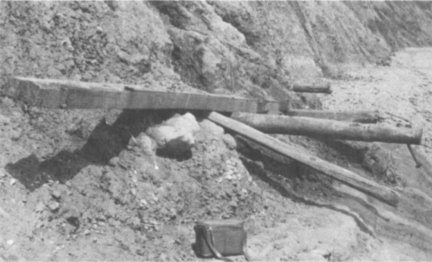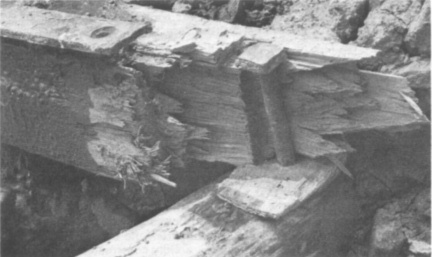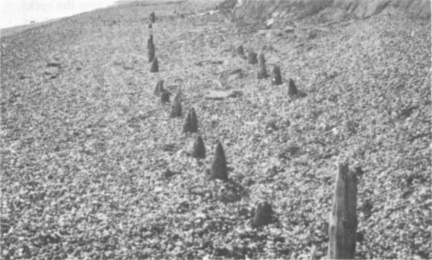
| THE INDUSTRIAL RAILWAY RECORD |
© AUGUST 1974 |
THE SIDMOUTH HARBOUR COMPANY OF 1836
M.J. MESSENGER
Sidmouth is a small seaside resort in East Devon which rose from a fishing village to a "watering place" popular with royalty at the beginning of the last century. There is no harbour but there have been many plans and schemes and today there is still talk of a marina. One harbour scheme is of particular interest as it involved an industrial railway of some length.
In 1835, when the sea-wall was being constructed, the recurring suggestion of a harbour was made and despite a lack of financial support plans were called for. William Cubitt was unable to produce estimates within the hoped-for resources and Henry Habberley Price agreed to act as Engineer. An Act (6‑7W4 cap.cxiii) was obtained in 1836 authorising a capital of £18,000 and work commenced early the following year. On 24th May 1837 two foundation stones, one for each pier, were laid midst great ceremony. That for the western pier was laid on behalf of the Russian Embassy, for the pier was to be named after Her Imperial Highness The Grand Duchess Helena of Russia; while the eastern pier was to be named after the Princess (later Queen) Victoria and its stone was laid with full Masonic honours by the local Masonic Lodge who turned out in craft regalia. It was also Victoria's birthday and the whole town was en fete, the junketings continuing until late that evening.
The two L‑shaped piers were to enclose some 10 acres at Chit Rocks, to the west of the town, and the stone for their construction was to come from generous natural deposits at Hook Ebb, a mile and a half to the east. The foundation stones had been brought by lighter and one faction of the Company's shareholders felt this an adequate means of transport. However, Price decided a railway was necessary and accordingly expended a large sum in laying one down, though work ceased during the winter of 1837 and the storms did much damage. At a meeting in February 1838 it was decided to repair the railway and make further calls on the share capital but one suspects the latter course met with little response; some £8,000 had been spent and construction of the harbour had not actually commenced. Earlier the Company's first Chairman had been hauled before arbitration accused of dishonour as he had not taken up shares he had subscribed for! Although the railway must have been nearly complete and the February meeting expressed "great confidence" little more appears to have been done and the equipment, machinery and the Company itself all quietly faded away, leaving two squared blocks on Chit Rocks and the remains of a railway.

|
|
|
|
|
Plan and elevation of remains of the Sidmouth Harbour Co railway. The wrought iron strip was alternately spiked and bolted to the timber rail at approximately 2ft 6in intervals. The sleepers were at roughly 3ft centres and rounded although that at the rail joint was sawn oblong (6in by 4in). The plan shows that at the particular joint shown the inner end of each sleeper was let into the rock face. |
What of the railway itself? East of Sidmouth only a narrow shingle beach separates the cliff from the sea and after laying his line the length of the front Price crossed the River Sid on a timber viaduct and tunnelled into Salcombe Cliff to protect the railway from the sea. After about a third of a mile the line emerged and continued along the foot of the cliff on piles to beyond Salcombe Mouth, where the red sandstone of Devon gives way to the limestone of Dorset.
After work ceased nature and other persons removed the railway, but a cliff fall covered part and storms a few years ago revealed a thirty feet length of track. Subsequent seas frustrated a salvage attempt but in the meantime much information had been gained. The first surprising point is that the track was a woodway, probably because of its temporary. nature. The rail was a timber baulk 6½in by 4in and 19 feet long. On its top inside edge (the bearing surface) was alternately spiked and bolted a wrought iron strap rail tin wide by 3/8 in thick and 15ft 6in long. Only the inside rail survived but from the. bolt holes in the circular section sleepers the gauge was deduced as 3ft 6in. The track was very solidly constructed and in an excellent state of preservation. This section was on a ledge of rock but elsewhere it had been supported on pairs of piles 5ft apart at 4ft 6in intervals. Movements in the shingle beach periodically reveal stumps standing in rows below the cliff. Each pile has a barbed iron tip at its lower end to anchor it into the rock. The famous Devon smuggler, Jack Rattenbury, in his 'Memoirs' states he gave up smuggling to carry stone for the Harbour Company, but perhaps he returned to his former profession for during the last century the tunnel was blocked to thwart smugglers, who found it a convenient store. Certainly he could not have got very fat from working for the Company! The tunnel is now flooded but the cliff has been eroding for years and eventually it will be opened up. At the Sidmouth end it is 6½ft high and 7½ft wide.
A mystery surrounds the suggestion that a locomotive saw use on the line. In 1870 an eccentric antiquarian named Peter Orlando Hutchinson wrote a "History of Sidmouth" which was never published, and the following paragraph is based on information in his manuscript. Although he has been proved accurate in other facts I have been unable to corroborate anything he has to say regarding locomotives. A local blacksmith by the name of Coles, Hutchinson says, was commissioned to make a machine to run on the rails to bring the stone but as it was only worked by the feet it was underpowered and a steam engine was sent for! Like all machinery at that period, this arrived by sea and the vessel was grounded on Sidmouth beach. Unfortunately there was no crane sufficiently powerful to unload the engine and the ship was floated off and sailed to Exmouth to unload. The engine was then "drawn over the hills to Sidmouth which place it entered decorated with laurels as if in triumph amid the greatest enthusiasm". To cap this rather comic tale the thing proved too large for the tunnel but was according to Hutchinson put to good use giving rides along the esplanade. The local newspaper, the "Exeter Flying Post", makes no mention of the introduction of locomotive power, an event unlikely to escape their attention: they keenly watched the progress of the harbour and in 1837 there were no other railways in Devon with steam locomotives. However, no steam without fire...
 |
Section of railway exposed by cliff fall. (M.J. Messenger) |
 |
Close-up of exposed section of rail. Note the wrought iron running surface and rounded sleeper: (M.J. Messenger) |
 |
Remains of piles used to support the railway on the beach section, looking west towards Sidmouth. The two lines of piles are 5ft apart: in each line piles are set at 4ft 6in intervals. (M.J. Messenger) |
Significantly, H.H. Price was a partner in the Neath Abbey Ironworks, which was building locomotives during this period, and doubtless any loco would have come from this source. Unfortunately very few Neath Abbey records have survived and those that do, I am told, show no apparent link with Sidmouth Harbour. One is forced to ask if an accomplished engineer such as Price would not have allowed for the height of the tunnel when he ordered the locomotive? Or made proper arrangements for its delivery? Another point is that Exmouth had no harbour facilities until 1864 before which time vessels unloaded offshore into lighters. However, this method may have been possible for off‑loading a locomotive, by using the hoisting gear of a larger ship. As I have said, a diligent search of the columns of the "Exeter Flying Post" of the period has revealed no reference whatsoever to an engine on the railway.
Was this, then, Devon's first railway locomotive, and an industrial to boot, or was it merely a figment of Peter Orlando Hutchinson's imagination? Unless anyone knows of a second-hand 3ft 6in gauge locomotive turning up in the late 1830's quite possibly we shall never know.
I am indebted to the following organisations and institutions for access to various information, Hutchinson's manuscript and the "Exeter Flying Post": Sidmouth Museum, Devon County Record Office, Exeter City Library, Devon & Exeter Institution, Lodge of Perseverance No 164 Sidmouth, Cornwall County Record Office, Glamorgan County Record Office and various friends in the IRS, the Railway & Canal Historical Society and the Trevithick Society.
Issue No.655, dated week ending 4th August 1900, of the Great Central Railway's "Permanent Way Notices, Alteration of Signals, & other Arrangements" gives details of various works on which contractors' locomotives were (or may have been) used. At Bagthorpe Junction, some 1,189 yards north of New Basford station on the main line between Annesley and Nottingham, it was reported that trailing points had been put in the up main line 100 yards north of the signal box, giving a temporary connection with the Contractors' ('Messrs. Logan and Hemingway') siding. The Banbury branch, diverging from the main line at Culworth Junction, was already open to goods traffic (as from 1st June 1900) but the inauguration day of passenger trains (13th August) was still more than a week away. Material still needed to be removed from the Contractors' Yard at Thorpe, and trailing points had been fixed at 4 miles 1 chain on the Down Line to allow access to the Contractors' Train. Trailing points had also been laid to connect with the Contractors' Siding at 0 miles 77 chains on the Up Line to facilitate the removal of ballast from the Ballast Heap there. The Contractors' Trains, presumably worked by the Contractors' locomotives, were accompanied by a GC guard. On the St. Helens line, a new signalbox (Edge Green and Golborne Box) erected alongside the Up line 845 yards west of Golborne Station, had been brought into operation: points had been laid in the Down Main Line - 245 yards east of the box to connect with the Edge Green Colliery branch, and 10 yards west of the box to give connection with the Golborne Colliery branch. On the Barnsley branch of the Lancashire & Yorkshire Railway, the un‑named Contractors engaged in widening the line were blasting rock at the north end of Woolley Edge tunnel 'until further notice': on 29th July connections were to be laid in the down line at Crigglestone for the Contractors' Siding. John Marshall, in Volume 1 of "The Lancashire & Yorkshire Railway" (David & Charles, 1969) identifies the Contractors as Baldry & Yerburgh, the contract being to construct a new single line tunnel at Crigglestone together with the fork line from Crigglestone to Horbury. – KPP
In the GCR's "Special Traffic Arrangements and Engineering Works in the Northern & Eastern Districts" for week ending 30th April 1910, mention is made that the Up line was absolutely blocked on Sunday 24th April between Warmsworth Siding and Hexthorpe Junction (near Doncaster), all traffic being worked over the Down line in the charge of a pilotman. The cause of this disruption was blasting at Hexthorpe Junction Box, where the railway cutting (through magnesia limestone) was being widened by an un‑named contractor whose "Engine and Wagons will run on to the Main Line at Hexthorpe Junction to remove rock, &c., if necessary". Is anything known of the contractor and the locomotive(s) employed?
– TJL